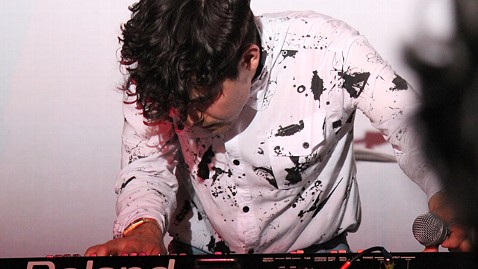Neon Indian's Alan Palomo: Electronic Artist Meets Film Geek
Neon Indian's Alan Palomo discovered electronic music as a teenager growing up in San Antonio, Texas. Precisely because it wasn't such a common thing to have around, Palomo, who as a boy in a Mexican-American household listened to a blend of Michael Jackson, Doobie Brothers and Luis Miguel, found himself latching on to the avant-garde:
"When you did meet those people that were doing [electronic music] or had their own group, or [were] collecting that sort of equipment or making their own stuff, or just had any sort of vested interest in it, immediately everybody would just kind of stick together and try to help each other out," Palomo told AudioFile before taking the stage at the Museum of Modern Art in New York City.
The benefit performance for The Armory Show in March 2012 kick-started Neon Indian's North American tour in support of the band's newest album, " Era Extraña," released on Mom + Pop in September 2011.
Approaching their sophomore record, Palomo, who composes and provides vocals for all of Neon Indian's tracks, found himself in a new situation in which he had been in a band and completed a tour. In fact, the band had toured for almost two years off of the 2009 debut, " Psychic Chasms." When it came time to start writing again, Palomo's first instinct was to get away. He did - all the way to Helsinki, Finland.
While he swore he wasn't trying to be dramatic, Palomo admitted, "In hindsight, I feel definitely it did come off as this very grandiose gesture of, like, 'And then he went to the edge of the Earth,' which it was not necessarily the case. But it was deep culture shock. And the environment did lend itself to sitting indoors and just staring at your instruments until songs would happen."

Neon Indian performs for The Armory Show at the Museum of Modern Art in New York City on March 7, 2012. (Patrick Ainslie)
During his time of self-imposed solitary confinement abroad, Palomo began to feel cabin fever. He attributed it, in large part, to bringing "all the wrong kinds of movies." His mini library consisted of a mixed bag of mindless entertainment ("Robocop" and " Dunston Checks In") and what he described as "drab, depressing, brutal stuff" ( Lars Von Trier's "Europa" and "Antichrist" and Werner Herzog's "Stroszek").
Palomo had initially set off for college as an aspiring filmmaker, and it's when collaborating on Neon Indian's visual aesthetics that he is most in his element. He recalled riffing on the phone for two hours with Tim Nackashi, the director of the " Polish Girl" music video:
"We had this simple sort of concept of the humanoid that's data mining," he said. "And then from there, I think at the time I'd be reading a lot of ' Neuromancer,' the Akira graphic novels, all this sort of cyberpunk stuff. We just started building on a lot of those images, and a lot of those things that we really liked from a lot of those films and books, and wanting to see if we could create some contemporized version of that. 'Cause I'm very curious as to what a term like cyberpunk could mean in year, like ,2012, as opposed to when it was really popularized, which is before the Internet was really part of anyone's lives, you know, in the late '80s and early '90s. So the video was our way to play around with that."
When it comes to music, Palomo views the Internet a "double-edged sword" for the ways in which it has changed people's consumption of records and, in turn, is changing the way artists write and release records. He compares Brooklyn records from the early 2000s to the current trend of more-focused and easily accessible tracks - from "some crazy 16-minute tribal freak-out with samples and all sorts of weird modular stuff everywhere" to "three-minute pockets of music" in the form of a "downloadable, 8-megabite file that's going to sit on your desktop until you decide to listen to it."
In direct contrast to Palomo's complicated relationship with the digital age is his sense of nostalgia. He easily conjures up tangible memories of the first cassette tape he ever owned: the soundtrack to " Teenage Mutant Ninja Turtles II: The Secret of the Ooze," which he described as consisting of "really, really cheesy house music."
"It's funny revisiting that now, and then in some strange way you always come back to that first random exposure to pop culture," Palomo said.
Going even further back, he relished that first taste of the infectious, new wave radio hit, " Blue Monday" by New Order: "I think the first time I heard New Order, I was three or four years old. It was in the backseat of my cousin's car, and we were just driving around. And then when I rediscovered it as a 17-year-old, and then realized that I had heard this song my entire life and never realized that it was my favorite song until now, and definitely continues to be."
Follow us on Twitter at @ABCAudioFile.